From Hirschhorn to Eberbach
Our trip takes us past Neckarhausen where one of the pretty side valleys joins the Neckar, alongside the railway line to Hirschhorn in which we see one of the most charming, almost medieval, little towns. Here, by means of the fortified galleries stretching down to the houses combined with town wall and gateway, castle and town had become a fortress. With the shining, towered castle it is still an unusually romantic and picturesque scene. The lords of Hirschhorn were once powerful and wealthy knights, and like the Steinachers, closely connected with the electoral court in Heidelberg and with the history of the Palatinate. Adolf Schmitthenner's fine novel “Das deutsche Herz" — "The German Heart" — gives a lively description of one of the most remarkable periods of this history. Up above in the castle we find buildings from the most various periods, among them the sturdy watch tower, still in good condition, up which the visitor can climb, the castle with a beautiful renaissance gable, the castle chapel with frescoes from the 14th century, the extremely attractive castle gateway and, on the slope, forts with towers and transoms. For a long time the knights of Hirschhorn also owned Zwingenberg Castle and thanks to their wealth they were once able to lend the count palatine 40.000 guldens, a very large sum for the 15th century. On the slope between castle and town stands the wonderful Gothic Carmelite church with remains of a rich and artistic interior and with magnificent tombstones of Hirschhorn knights. In the town below, however, we find richly ornamented framework houses and peaceful, romantic corners, a delight to the heart and eye.
In Ersheim, opposite, which was once of considerable size and gradually disappeared — probably on account of flood danger — we find the ancient Gothic chapel and graveyard in which all those who died in Hirschhorn were formerly buried. The chapel is especially fascinating on account of the remains of walls from the earliest period of church-building in the Neckar Valley, the remarkable statues and woodcarvings and an unusually beautiful ceiling. In the graveyard there is a conspicuous Gothic stone for which various explanations have been given. It has been described as a stone of misery, as a beacon for the dead, or as a sign of exhortation and a reminder for the monks leaving the one-time monastery church.
When farther upstream Pleutersbach appears to the right, Eberbach soon comes into sight, the one-time free imperial city and today the largest town after Heidelberg in the Badenian part of the Neckar Valley. It is surrounded by vast forests, formerly the origin of many branches of trade, for instance of shingling and hoop-making, but most of these old handicrafts have disappeared. They have long since been replaced by other kinds of trade now important for Eberbach's industrial strength. Eberbach Castle was first mentioned in 1227: thus in 1927 the town could celebrate its seven hundredth anniversary. Castle and town were already important in the Middle Ages. There were three castles immediately next to one another and in olden times Eberbach was often mentioned as a free city. The centre of the town still shows much evidence of those days, for instance, some remarkable towers hidden between the houses, the former "Kellerei" with striking gables, remains of the town walls and among many frame-work houses especially the beautiful group with the "Court" and the old barracks in which the University of Heidelberg sought refuge to escape the plague in the 16th century. The highest mountain in the Odenwald, the Katzenbuckel (Cat's Back), is close to Eberbach. On our way to it we find the remains of Eberbach Castle only half an hour away from the town. It is well worth visiting and there is a fine view of the town and the beautiful woods surrounding it.
In Ersheim, opposite, which was once of considerable size and gradually disappeared — probably on account of flood danger — we find the ancient Gothic chapel and graveyard in which all those who died in Hirschhorn were formerly buried. The chapel is especially fascinating on account of the remains of walls from the earliest period of church-building in the Neckar Valley, the remarkable statues and woodcarvings and an unusually beautiful ceiling. In the graveyard there is a conspicuous Gothic stone for which various explanations have been given. It has been described as a stone of misery, as a beacon for the dead, or as a sign of exhortation and a reminder for the monks leaving the one-time monastery church.
When farther upstream Pleutersbach appears to the right, Eberbach soon comes into sight, the one-time free imperial city and today the largest town after Heidelberg in the Badenian part of the Neckar Valley. It is surrounded by vast forests, formerly the origin of many branches of trade, for instance of shingling and hoop-making, but most of these old handicrafts have disappeared. They have long since been replaced by other kinds of trade now important for Eberbach's industrial strength. Eberbach Castle was first mentioned in 1227: thus in 1927 the town could celebrate its seven hundredth anniversary. Castle and town were already important in the Middle Ages. There were three castles immediately next to one another and in olden times Eberbach was often mentioned as a free city. The centre of the town still shows much evidence of those days, for instance, some remarkable towers hidden between the houses, the former "Kellerei" with striking gables, remains of the town walls and among many frame-work houses especially the beautiful group with the "Court" and the old barracks in which the University of Heidelberg sought refuge to escape the plague in the 16th century. The highest mountain in the Odenwald, the Katzenbuckel (Cat's Back), is close to Eberbach. On our way to it we find the remains of Eberbach Castle only half an hour away from the town. It is well worth visiting and there is a fine view of the town and the beautiful woods surrounding it.
Dieses Kapitel ist Teil des Buches The Neckar Valley. From Heidelberg to Wimpfen
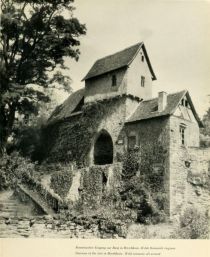
025 Romantischer Eingang zur Burg in Hirschhorn
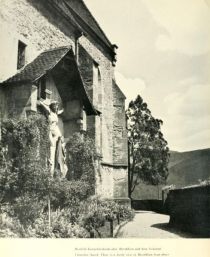
026 Herrliche Karmeliterkirche über Hirschhorn und dem Neckartal
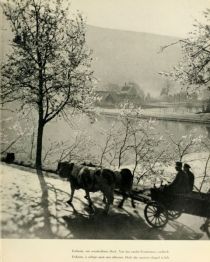
027 Ersheim, ein verschollenes Dorf. Nur das uralte Gotteshaus verblieb
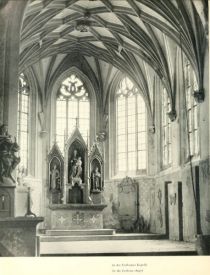
028 In der Ersheimer Kapelle
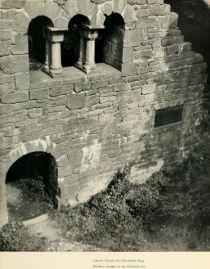
029 Schönes Fenster der Eberbacher Burg
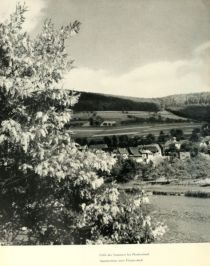
030 Fülle des Sommers bei Pleutersbach
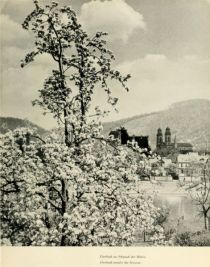
031 Eberbach im Schmuck der Blüten
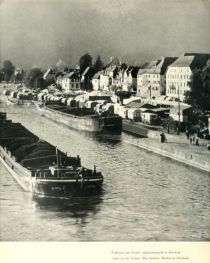
032 Volksfest am Neckar - Kuckucksmarkt in Eberbach
alle Kapitel sehen